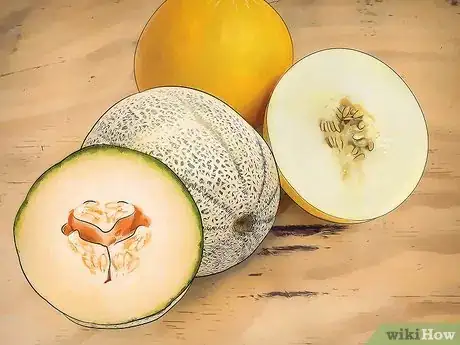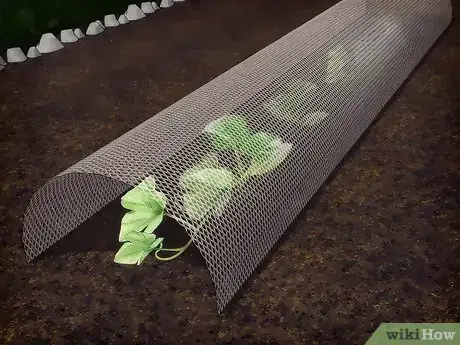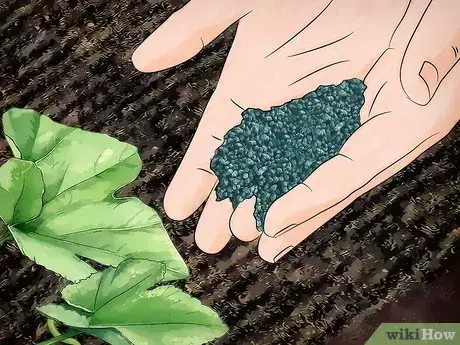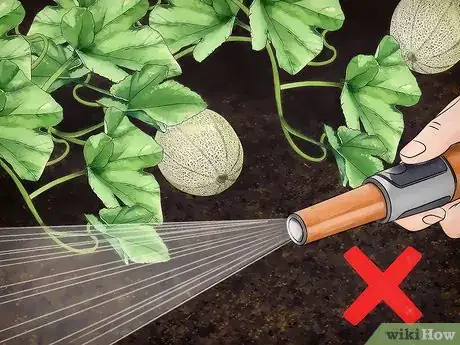This article was co-authored by Andrew Carberry, MPH. Andrew Carberry is a Food Systems Expert and the Senior Program Associate at the Wallace Centere at Winrock International in Little Rock, Arkansas. He has worked in food systems since 2008 and has experience working on farm-to-school projects, food safety programs, and working with local and state coalitions in Arkansas. He is a graduate of the College of William and Mary and holds a Masters degree in public health and nutrition from the University of Tennessee.
There are 7 references cited in this article, which can be found at the bottom of the page.
wikiHow marks an article as reader-approved once it receives enough positive feedback. This article received 18 testimonials and 92% of readers who voted found it helpful, earning it our reader-approved status.
This article has been viewed 360,945 times.
A freshly ripened cantaloupe straight from your own garden is one of the summer's greatest pleasures. There are hundreds of varieties of cantaloupe to choose from, but the classic Hale's Best, a popular melon with old-time growers, is one of the best. Whatever variety you choose, you can learn to prep the ground for planting, care for your budding melons, and identify common problems throughout the growing process to give you the best chance for success.
Steps
Prepping the Ground and Planting
-
1Select a hardy variety appropriate for your climate. Cantaloupes, also known as muskmelons, are available in dozens of cultivated and heirloom varieties, and grow best in hot weather, at least 2-3 months of consistent warmth. Cantaloupes love very sandy and loamy soil with good drainage, and a pH of around 6.
- Varieties good for cooler climates include Hale's Best, Sarah's Choice, and Eden's Gem. Varieties noted for their flavor include Hearts of Gold, Ambrosia, Athena, and Honey Bun.
- Pay particular attention to the time to maturity listed on the seed package. Most of the time, you won't buy cantaloupe starts, you'll purchase seeds and start them yourself. On the seed package, pay particular attention to planting advice and information about keeping them safe, and pay particularly close attention to the length of time to maturation.
- If you want to save cantaloupe seeds from a particularly-delicious melon for planting, scoop them from the flesh and soak them for two days in cool water, then dry them thoroughly on a paper towel. Store them in a clean, dry jar in a cool, dark environment until you're ready to start your melons. While viable for around two years, it's usually best to plant seeds within the year.[1]
-
2Select an appropriate location for cantaloupe. The most important part of planting and growing cantaloupe is warm soil and enough space. The vines need some room to spread out, regardless of whether you plan on trellising or letting the melons mature on the ground, so you'll need a fairly wide bed, depending on how large a crop you're going to plant.
- It's a common misconception and fear that cantaloupes will cross with other members of the same family, including cucumbers, other melons, squash, and pumpkins. They won't. Don't worry about planting your vining fruits in the same area of your garden plot. Most strange or bland-flavored cantaloupe is not the result of accidental cross-breeding, but the result of environmental factors or other problems.[2]
Advertisement -
3Prepare the soil. Lay compost or well-rotted manure evenly on your planting bed to create a rich feeding area for the cantaloupe. 6-8 inches of well-tilled soil is appropriate, plus your fertilization matter.
- Start cultivating soil by tilling the ground at least a foot deep, aerating and thoroughly mixing the rough soil, removing any rocks, twigs, or other hard bits. Mix in a thick layer of manure and a smaller layer of compost on top, replacing the earth you excavated. Cantaloupes grow best on mounds, slightly raised above the surrounding ground, so don't worry if you've created a big bulge in the ground.
- If you want, it's common to cover the ground of your plot with plastic film or weed matting prior to planting, to speed the warming process of the soil. It's important to plant cantaloupe starts in warm soil to promote healthy growth.[3]
-
4Consider starting cantaloupe indoors. If you knew the exact date of the last frost of the season, planting cantaloupe would be a snap. Ideally, cantaloupes will be direct-sowed approximately 10 days before the last frost, earlier in warmer climates. Because that date is ever more difficult to determine, it makes starting your cantaloupe indoors a somewhat more grower-friendly method.[4]
- If you live in a cooler climate, start seeds indoors by sowing them in biodegradable seedling pots filled with rich planting soil. Moisten the soil generously, but without standing water. After a month or so, once the plants have a few mature leaves, you can transplant the entire biodegradable pot into your garden without disturbing the fragile root system.[5]
- If you live in warmer climates, you can direct sow seeds when the soil temperature warms to at least 65 degrees to avoid poor germination.
-
5In your plot, create mounds for planting. Cantaloupe should be planted in rows of raised mounts, with each row at least 4 feet (1.2 m) apart. The spacing within a row depends on how you plan to grow your melons:
- If you want to grow cantaloupe on trellis poles or wires, space hills in the same row about 12 inches (30.5 cm) apart. Trellising typically only works for smaller melon varieties.
- If you plan to grow the cantaloupe on the ground, space the hills 36 to 42 inches (91 to 107 cm) apart.
-
6Plant your cantaloupe. Wait for the ground to warm to at least 70 °F (21 °C), sometime after the final frost of the season. Depending on where you live, this may be earlier or later in the planting season.
- If you started your cantaloupe indoors, plant your biodegradable pot in the middle of each mound, as close to the center as possible. Wet the soil generously during planting.
- If you're direct-sowing seeds, drop 5 cantaloupe seeds about one inch deep, 18 inches apart, in hills about 3 feet (0.9 m) apart.
Caring For Cantaloupe
-
1Water the cantaloupe deeply and sparingly. Keep the soil around the young cantaloupe plants moist, but not standing in water. They should get around 1 or 2 inches a week. Cantaloupe will be very sensitive during periods of drought and may need additional watering, so use your judgment and keep a close eye on the plants to make sure they're growing and looking healthy.
- Melons will take a while to set on the vine, but most of the sugary flavor in a melon can be determined from the leaves. Just because you don't see melons yet doesn't mean that you don't know anything about how they will taste. Pay attention to the quality and vigor of the leaves: they should be dark green, with stiff structure and a healthy color. Yellowish or spotted leaves may be a sign of dryness or disease.
- It's typical for melon leaves to wilt significantly in the midday and stay wilted looking until the evening in extremely hot weather. This isn't necessarily a sign that you need to water the cantaloupe more, however, so look at the quality of the leaves, not the limpness.[6]
- Drip-tape can be quite effective in watering your melons, but you can also hand-water or do whatever is appropriate for the size of your plot and other planting projects. Water around the base of the vines and try not to get the fruit wet, when it sets.
-
2Protect the fruits as they begin to grow. Whether you're growing new plants or have transplanted your starts, it's a good idea to cover your rows with floating row cover in order to keep them warm and protect them from insects. You can use small loops of chicken wire to create a tunnel, then drape your netting over the row.
- It's important to remove the matting after the threat of frost has dissipated and blooms have started to form, so that pollinating insects can reach the blossoms. You can cover the plants again once the fruits have set.
- Use weed killers and chemical pest controls only as a last resort. Read all label instructions to make sure the treatment is safe for use on edible harvests and will not kill pollinating insects.
-
3Weed the area thoroughly before the vines start running. It's challenging to walk around the thick network of vines, much less to weed it. To give your vines the best chance at growth, try to weed aggressively in the first couple of weeks of growth, and let them grow big enough to get a head start and beat out the weeds as the plant matures.
- One of the difficult things about growing cantaloupe directly from seed is that the budding cantaloupe plant looks an awful lot like clover, a weed that you'll want to pick. Because it would be a tragedy to pull your budding plant, try to mark your start with a plant card, or wait until it distinguishes itself from the clover to start pulling weeds.
- After removing weeds, add a thick layer of mulch around vines to suppress weed growth and help the soil retain moisture.
-
4Consider trellising cantaloupe. Depending on how you've set up your growing patch, it may be appropriate to trellis your melons so they can grow off the ground. A fence-style trellis set low to the ground is the most effective for growing cantaloupe.
- To train the vines, start by planting poles at least 6 feet (1.8 m) tall at each mound in your melon row, or up to 8 feet (2.4 m) tall for large varieties in warm climates.[7] You can use metal wire, planks of wood, thick twine, or any other available supplies to connect the poles and provide something for the vines to cling to. Train the vines up along the poles to get them started.
- To support the fruit, give them something to rest on or in to lessen the load on the vines. Place the fruit on raised mulch beds or pedestals like upside down cans or pots. You can cover the fruits with milk crates or similar protection if they are under attack by ground hogs or other animals.
- When your vines start fruiting, melons seated directly on the ground are more prone to rot and being picked off by critters. If you expect damp weather near the end of the growing season, trellising is a good way to protect your melons. If the melons started on the ground, however, don't try to trellis them mid-growth.
-
5Fertilize plants periodically. During the growth process, it is somewhat common to use a nitrogen fertilizer on plants that have not bloomed, or seem to be moving slower than other plants. Lining some coffee grounds around the root system can be an effective way of waking up the plant.
- It's also common to fertilize cantaloupe with a higher potassium and phosphorus fertilizer after the blossoms have opened, though long time deposits of phosphorus fertilization can be environmentally hazardous. Line organic matter like compost or manure around the root system if they're lagging.
-
6Withhold some water just before the cantaloupe reaches full ripeness. Too much watering can dilute the sugar content in the melon as it ripens and affect the flavor of the fruit. It's common to hold back on your watering in the last week before you harvest the melons.
- When a cantaloupe is ready to pick, the stem will start cracking slightly where it meets the stem. It's overripe when it falls off completely.[8] It's also common that you'll start smelling the distinctive musky smell of a ripe melon when you're near the patch. If you can smell cantaloupe, they're ready to pick.
- Most varieties of cantaloupe will ripen within 4 weeks of appearing on the vine, though pay attention to the guidelines of the particular variety you're cultivating for more specific instructions.
Troubleshooting Cantaloupe Problems
-
1Learn to recognize common pest infestations. Because they lay around the ground, melon vines are particularly susceptible to pests like insects, mites, and leaf miners. To keep from worrying, you can learn to recognize common problems and figure out whether or not you've got a serious problem.
- Root knots and swelling mean nematodes, a significant problem that you won't be able to take care of this season. Pull up your plants and sew some cereal rye into the soil to cleanse it.
- Stickiness and wilting mean aphids, which can be treated with Theodan or other organic insecticides such as diatomaceous earth or essential oil & olive oil mixtures.
- Leaf tunnels and trails mean leaf miners, which isn't something to worry about. They shouldn't affect the fruit significantly.
- Yellow webbed leaves mean spider mites, meaning that plants will need to be removed, if the small red mites are significant enough.[9]
-
2Recognize the symptoms of common blights. Grown and watered properly, your cantaloupe should be fine most of the time. Occasionally, though, ground-vining fruit are susceptible to blights and diseases that can ruin crops if not treated immediately. You can learn to recognize the most-common varieties of blight, so you can pull up the plants and save your other crops, or start a fungicidal regimen, depending on the severity.
- Yellow spots with downy undergrowth signify downy mildew. This is sometimes treated with chlorothalonil, or other organic-based wide-spectrum fungicide, though it shouldn't be necessary for most gardens. Proper trellising of vines should help circulate air and eliminate the possibility of mildew.[10]
- Broken stems emitting amber-colored liquid means gummy sap blight. This is a soil-based blight, which means the crop will likely die this season, but you can treat sap blight by rotating varietals around your plot, and possibly using a selective fungicide.
- Fruit rot after rain means southern blight. In regions with heavier soil, this is a common problem. Avoid over-watering and mulch between the plant and the soil to prevent rot.
-
3Learn why vines sometimes won't set fruit. After going to all the trouble to prep your ground and start your cantaloupe, there's nothing more frustrating than a mess of vines that never sets any melons. Learning from this experience, though, can help ensure that you'll have fruiting vines in the future. Most fruiting problems are the result of one of three things:
- A lack of pollinating insects can result in healthy-looking vines that never set. Cantaloupe vines produce male and female flowers, and pollination between them is necessary for fruiting. If you're growing cantaloupe in a greenhouse, or live somewhere that bees are scarce, you might need to pollenate by hand.
- Improper ground temperature will force the plant to only produce male flowers, which makes it difficult to fruit, even if pollinating insects are very present. Make sure you wait to put your plants in when the soil is around 65 °F (18 °C).
- If your melon plants struggle to produce, but you're doing everything by the book, try tilling some cereal rye in plots you plan on growing in for next season about a month before putting your plants in the ground.
Expert Q&A
-
QuestionShould I snip the end of each vine to stop it from growing? Would this promote better yield of melons?
 Andrew Carberry, MPHAndrew Carberry is a Food Systems Expert and the Senior Program Associate at the Wallace Centere at Winrock International in Little Rock, Arkansas. He has worked in food systems since 2008 and has experience working on farm-to-school projects, food safety programs, and working with local and state coalitions in Arkansas. He is a graduate of the College of William and Mary and holds a Masters degree in public health and nutrition from the University of Tennessee.
Andrew Carberry, MPHAndrew Carberry is a Food Systems Expert and the Senior Program Associate at the Wallace Centere at Winrock International in Little Rock, Arkansas. He has worked in food systems since 2008 and has experience working on farm-to-school projects, food safety programs, and working with local and state coalitions in Arkansas. He is a graduate of the College of William and Mary and holds a Masters degree in public health and nutrition from the University of Tennessee.
Food Systems Expert Studies show that cutting the vines back doesn't increase fruit yield. The plant needs all of its leaves to create sugars for the melons.
Studies show that cutting the vines back doesn't increase fruit yield. The plant needs all of its leaves to create sugars for the melons. -
QuestionHow do you know when cantaloupes are ready to be picked?
 Andrew Carberry, MPHAndrew Carberry is a Food Systems Expert and the Senior Program Associate at the Wallace Centere at Winrock International in Little Rock, Arkansas. He has worked in food systems since 2008 and has experience working on farm-to-school projects, food safety programs, and working with local and state coalitions in Arkansas. He is a graduate of the College of William and Mary and holds a Masters degree in public health and nutrition from the University of Tennessee.
Andrew Carberry, MPHAndrew Carberry is a Food Systems Expert and the Senior Program Associate at the Wallace Centere at Winrock International in Little Rock, Arkansas. He has worked in food systems since 2008 and has experience working on farm-to-school projects, food safety programs, and working with local and state coalitions in Arkansas. He is a graduate of the College of William and Mary and holds a Masters degree in public health and nutrition from the University of Tennessee.
Food Systems Expert As they ripen, cantaloupes will start to smell sweeter. Try smelling them up close and you'll notice a difference when they are ripe.
As they ripen, cantaloupes will start to smell sweeter. Try smelling them up close and you'll notice a difference when they are ripe. -
QuestionShould I pick the blossoms off the vine while the plant is fruiting?
 Community AnswerNo, the fruit comes from the flower. Male and female flowers depend on each other for fertilization. Only pick them off if you don't want any fruit.
Community AnswerNo, the fruit comes from the flower. Male and female flowers depend on each other for fertilization. Only pick them off if you don't want any fruit.
Warnings
- Cantaloupe vine leaves can be attacked by insects and fungus. The quality of the leaves contribute greatly to the sweetness of the fruit. Ensure that the leaves of the vines are in good condition.⧼thumbs_response⧽
Things You'll Need
- Rich composted dirt
- Trellis
- Cantaloupe seeds or plants
- Water
- Fertilizer
- Mulch
- Cans or pots
- Crates
References
- ↑ http://homeguides.sfgate.com/prepare-fresh-cantaloupe-seeds-planting-22296.html
- ↑ http://aggie-horticulture.tamu.edu/archives/parsons/vegetables/cantalou.html
- ↑ http://bonnieplants.com/growing/growing-cantaloupe-and-honeydew-melons/
- ↑ http://homeguides.sfgate.com/prepare-fresh-cantaloupe-seeds-planting-22296.html
- ↑ http://www.extension.umn.edu/garden/yard-garden/fruit/growing-melons-in-minnesota-home-gardens/
- ↑ http://www.extension.umn.edu/garden/yard-garden/fruit/growing-melons-in-minnesota-home-gardens/
- ↑ https://bonnieplants.com/growing/growing-cantaloupe-and-honeydew-melons/
- ↑ http://www.almanac.com/plant/cantaloupe
- ↑ http://aggie-horticulture.tamu.edu/archives/parsons/vegetables/cantalou.html
About This Article
To grow cantaloupe, till the soil with compost or manure, and create mounds for planting about 1 foot apart. If you live in a colder climate, start your cantaloupe indoors about a month before planting. Once the ground temperature is about 70 °F, plant the cantaloupe in the middle of the mounds, and keep the soil moist. You can protect the fruit from insects and keep them warm by covering them with chicken wire and netting. Before the vines begin running from the fruit, weed the area and fertilize the plants periodically. For more tips from our Gardener reviewer, including how to recognize pests, read on!












































































